Advice for Constructing and Maintaining a Wood Balcony
By Editorial Team
Updated on November 3, 2025
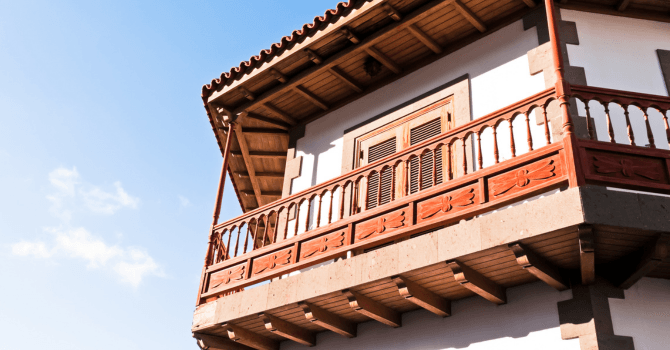
Over the last few years, we’ve come to really value our home space. Thereby, adding a wooden balcony is a great way to benefit from an additional retreat at home where we’re most comfortable and can take full advantage of the warmer seasons.
Get Your Project Started Today
Submit your details and receive three free quotes from trusted contractors.
Whether you’re thinking of doing the work yourself or handing off the project to a qualified individual, here are a few tips to guide your project to ensure the result meets your expectations!
What is a wooden balcony?
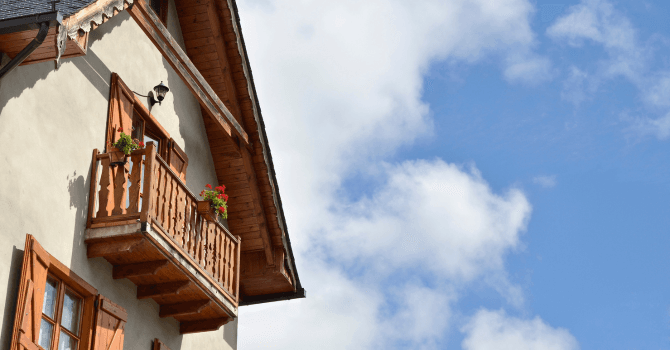
Source: Canva
The term wooden balcony is employed regardless of whether all parts are wood, merely one section, or its structure or flooring. It can be a combination of different materials or types of wood.
The platform is suspended to the building’s structure with tie rods and held in place with the help of vertical posts or pillars. A guardrail is also installed to prevent hazards and falls, given the distance between the ground and the balcony’s platform. Said railing can be made with the same material as the balcony or another material altogether.
Decks and balconies are designed to blend in with various types of structural aesthetics, with different purposes in mind. No wonder they’re so appealing to the masses!
Generally speaking, balconies are an extension of a building’s façade. It’s noticeably suspended or elevated. It’s fitted with a guardrail or railing, its style often reminiscent of the building itself.
How to Build a Wood Balcony
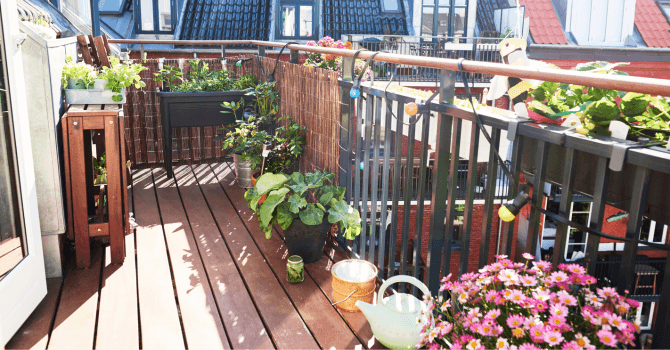
Source: Canva
Wood is amongst the most accessible materials and one of the easiest to work with. However, that doesn’t mean that it’ll make for an easy project to bring to fruition. If you choose the DIY route, note that the stages of building a balcony must be acutely followed for the process to be done according to good practices.
From a structural standpoint, many houses aren’t necessarily built to code, and some defects can present a risk to dwellers or worse, prematurely age the building materials. If you’re having second thoughts about venturing into such a project, note that many qualified contractors will have the necessary expertise to build your dream balcony.
Prior to undertaking your project, look into the current municipal regulations (dimensions, clearance between neighbouring yards, and authorized materials). Such a project may require a building permit; your plan or blueprint could require pre-approval.
Building a Balcony Whilst Building a House
Ideally, a feature such as a balcony must be planned during the house’s building process to plan ahead for a concrete wire mesh.
If your balcony and house are built at the same time, meaning the flooring platform is linked to the house’s framework, a cantilevered balcony is a way to go. As such, the balcony’s flooring will extend beyond the house’s structure. Thus, longer joists will be used to build the flooring structure. The floor joists will extend beyond the framework to form the wooden balcony’s skeleton.
Building a Balcony Post-Home-Construction
Adding a balcony once the house has already been built is a tad more complex. Depending on the method used to add such a feature, one will have to proceed with some demolition work beforehand.
If you choose to add a structural element post-construction, it’s best to hire a professional.
Option 1: Cantilevered balcony
With this version, the balcony is overhanging, without any supporting pilings. As such, floor joists are added to the structure’s façade to build the balcony’s skeleton. And, in terms of length, the balcony’s flooring will extend into nothing according to the pre-approved length.
Contrary to popular belief, adding a wooden cantilevered balcony is often the cheapest option. This type of structure is also aesthetically pleasing and has the benefit of being less imposing, visually speaking.
Option 2: Balcony affixed to façade with supporting legs
With this option, the balcony is attached to the façade, meaning it’s supported by wooden pillars positioned at all four corners, much like one would expect while building a patio.
What type of wood can you use to build a balcony?
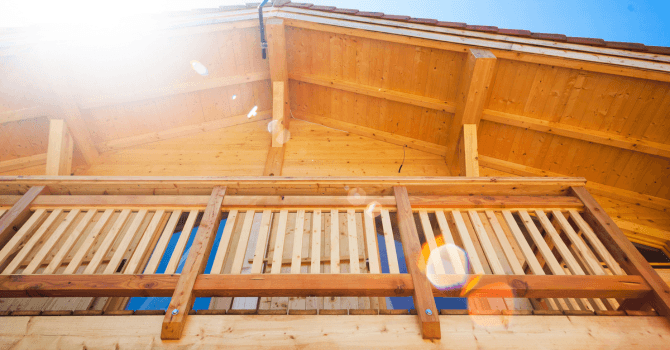
Source: Canva
Wood has an undisputable aesthetic and bar-none versatility, which makes for a cozy, tasteful, and elegant setting. By definition, a deck or balcony is, without a doubt, a must-have. Better yet, it blends in perfectly with any and all architectural styles and remains one of the most eco-friendly construction choices. No matter its size or design, it ends up being capital gain on your house as it’ll add overall resale value.
Wood is rich and timeless, from one century to the next. To ensure you’re fully benefiting from its undeniable qualities, carefully select the species according to its purpose. The durability of wood, in terms of outdoor use, varies between 10 and 50 years, depending on the species selected.
Different Types of Wood Species Used to Build a Balcony
White pine
White pine is soft and uniform and known for the ease with which it’s worked. It’s also available in various thicknesses, lengths, and widths. And, in terms of natural wood, it’s the least expensive option. However, it does require a bit of maintenance.
While cautionary measures are best followed, especially since this type of wood is vulnerable to markings of any kind and warping, you can still repair some of the damage inflicted over time.
A white pine balcony will last roughly 10 to 15 years, depending on the product used during the finishing stage.
Western redcedar
Originally from Western Canada, the redcedar is a regulated resource. This type of tree is very appreciated for its beauty, rich colour, and superior sustainability. Its distinct odour doesn’t hurt either!
The redcedar contains natural oil that acts as a mould barrier to prevent insect-inflicted damage. This type of wood also withstands temperature fluctuations brought on by Mother Nature in our neck of the woods really well.
A redcedar balcony can last more than 25 years, and made with sustainable materials and low-environmental impacts, it can be the best value-for-money option. The reap the benefits of this installation for as long as possible, it’s best to protect the wood against UV rays with specially made products.
Ipe
Ipe wood has a natural colouring that’s just absolutely exceptional. It’s a stable and durable wood that can adapt to Eastern Canadian climates. Ipe wood is termite-, insect-, fungi-, and mould-resistant, on top of having a density that’s just beyond. Its numerous advantages make it a top choice.
It’s also great for patio or terrace decking since it can last over 50 years. Its only downside—aside from its steep pricing—is that the wood’s density makes it very hard, which isn’t always easy to work with. It’ll often require the use of powerful tools.
Teak
According to most aficionados, teak wood is one of the most appreciated essences. As such, its beauty solely matches its durability. Its unique shade—a sort of ochre, golden yellow—and remarkable properties, render it an exceptional essence.
Teak is also rot-proof and perfect for terraces or used for various other outdoor purposes. Its main drawback lies in the fact that it has to be imported. Consequently, its price is rather steep.
Treated decking
Treated wood is a fan favourite when it comes to outdoor building projects. By definition, it very much resembles knotty cedar—especially when it’s stained dark, but it’s sold for a fraction of the cost. In fact, it’s by far one of the most economical decking options.
Installing the Decking
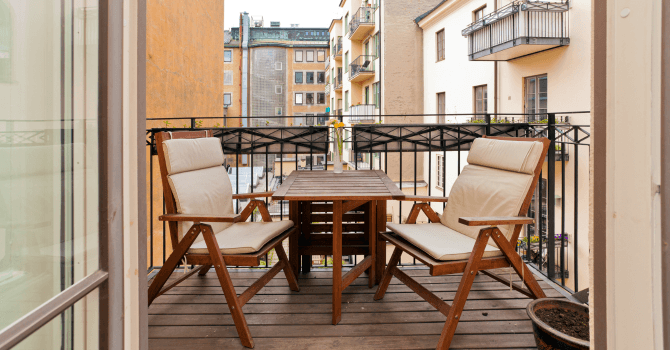
Source: Canva
There are different types of sheathing that can be used to cover a wooden structure such as moulded fibreglass, composite materials and synthetic polymers, wood planks, and plywood panels...
As mentioned, durability and aesthetic appeal depend on the chosen decking.
Are you looking to build a new balcony or repair your current balcony’s coating? As above-mentioned, various essences are available on the market. Some aren’t only sold as planks but also as panels or tiles.
To help you make a wise choice when selecting the decking most appropriate for this project, here’s a list of balcony decking features.
Wooden Deck Boards
This material is basically the most conventional and timeless option. Wooden deck boards are available in a variety of lengths and widths. Elegant to boot, it allows one to create various designs.
In terms of materials available, there are different wood essences, but also synthetic and recycled materials. There are two ways to go about laying your decking: spaced (open deck) or interlocking (solid deck).
Panelled Sheathing
The various panelled sheathing options for balconies are as such: BC Douglas fir plywood with a protective coating, fibreglass-covered plywood, and fibre cement. It can also be coated with fibreglass or a PVC membrane.
It’s often the go-to and economical move. Its seamless surface is easy to clean and can generally withstand harsh weather patterns. To ensure the sheathing’s durability over time, we recommend applying a protective coating. And, since it can’t be replaced section by section, some precautionary measures have to be respected to prevent damage over time.
Wood Deck Tiles
This one is a relatively new product on the market. Wood deck tiles are appealing due to their versatility. Tiles are good decking options for patios, saunas, pathways, and terraces.
They’re easy to install and bring life to unique and distinct concepts. We especially appreciate the fact they’re reusable. In fact, they can be moved, trouble-free, and reinstalled to one’s liking!
Leading Decking Brands and Product Lines Available in Canada
Selecting the right decking boards and supplies is just as important as choosing the design or type of wood. In Canada, several well-established brands offer high-quality products specifically suited for wood balconies and outdoor spaces. Here are some of the most reputable options available through major home improvement retailers:
Trex: Trex is a leading brand known for its durable and low-maintenance composite decking boards. Their products are designed to mimic the look of natural wood while offering enhanced resistance to weather, insects, and moisture. Trex decking is widely available at Canadian retailers such as RONA and Home Depot.
TimberTech: TimberTech offers a range of composite decking products that combine the beauty of wood with long-lasting performance. Their boards are engineered for strength and come in various styles and finishes. TimberTech products can be found at RONA and other major Canadian suppliers.
Azek: Azek specializes in premium capped polymer and composite decking, offering superior durability and a wide selection of colours. Azek products are an excellent choice for homeowners seeking a high-end finish for their wood balcony. They are available at select Canadian retailers, including RONA.
Well Made Here: This brand focuses on quality materials manufactured in Canada, offering decking solutions that meet local climate and building standards. Well Made Here products are available through RONA.
Classic Railing: For railings and balcony accessories, Classic Railing provides a variety of railing systems that complement wood balconies. Their products are available at RONA and similar retailers.
Accessory Products: In addition to decking boards, you’ll find a wide range of accessory brands for posts, fasteners, stains, and wood treatments at Canadian retailers. For example, RONA stocks trusted hardware and finishing brands to help you complete your balcony project with confidence.
When selecting decking supplies or accessories, check with your local RONA, Home Depot, or Lowe’s to ensure availability and to get advice tailored to your region and project needs.
Wooden Balcony Maintenance
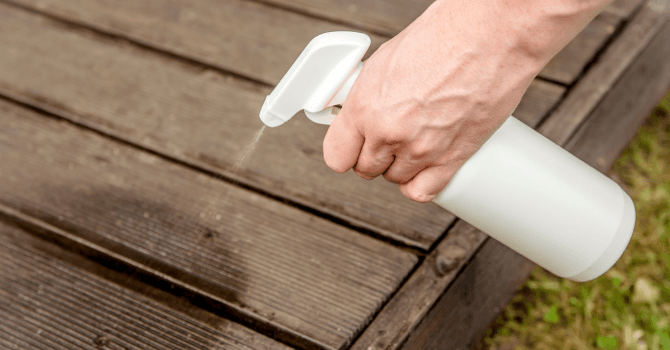
Source: Canva
A wooden balcony isn’t just practical, it’s downright fantastic. However, to reap the benefits for years to come, it does require a bit of maintenance.
Check the wooden structure
Regularly inspect the supporting structure (pillars, rim joists and intermediate joists) to ensure everything is up to par.
Make sure the materials touching the ground aren’t rotting. If necessary, repair or replace the damaged areas.
Check the state of the brackets supporting the structure.
If the decking is moulding or damaged, remove it and then replace it.
Ensure the guardrails, railings, and steps are sturdy. Resecure the latter if needed to prevent injuries.
Check the anchoring system, nails and screws. Switch out any protruding nails with screws.
How to Clean a Wooden Balcony
The structure must be cleaned thoroughly at the turn of every season and before the first snow to prevent dirt or grime from damaging the wood prematurely. And, note that there are very good products available for that very purpose.
Unfortunately, there is yet to be a no-maintenance-required, year-round solution. Wood, aside from chemically treated wood, requires regular maintenance or else it may deteriorate. Rot, sun exposure, pollution, and dirt are some of the elements that risk negatively affecting the wood’s appearance and resistance.
With the help of a specifically made product, you can protect your balcony from adverse weather and wear and tear. If you decide to stain the wood, note that you’ll have to repeat the process every two to three years. As for product selection, ask for a sales clerk to help you choose the one that’s best suited for the work at hand. Follow the manufacturer’s guidelines to know how and when to apply the product.
Combining anti-fungal sealers, solid paint, clear exterior stains, and linseed oil-based waterproofing products are all worthy options to consider.
Pro tip: Beware of pressure washers. A good scrubbing and rinse will get the job done just fine.
When and How to Sand a Wooden Balcony
Do you want to take advantage of the nice weather ahead to stain your wooden balcony?
Note that multiple factors come into play to ensure the best possible results. Besides the type of paint or stain chosen and waiting for the best weather to move forward, the prepping stage shouldn’t be overlooked. Here’s what you need to know.
Telltale signs that your balcony needs sanding
Here’s evidence that your balcony is in dire need of some TLC…
The paint or stain is chipped;
There’s mould;
The flooring is wearing or discoloured.
By properly sanding down the surface, the stain will really permeate the wood and better protect the balcony. After sanding down the wood, remove any residue to prevent dust from mixing into the stain or paint afterward. If needed, use a vacuum.
Sanding methods
There are two ways to sand a wooden balcony. The first way consists of doing it the old-fashioned way: manually, with the help of an electric sander and sanding paper.
The second one entails renting a floor sander. This tool is available in most rental locations. It’ll definitely save you time and energy.
Looking for something else?
Related articles
The latest industry news, interviews, technologies, and resources.

Amanda Harvey
•07 Nov 2023
Undergoing any form of home renovation is a huge venture that requires time, energy and patience. Of course, you can’t just grab a hammer and some nails and begin your renovation tomorrow, as plenty of preparation and planning must be fulfilled. If you are renovating a home in the city of Toronto, there are numerous regulations and bylaws that must be considered before performing any type of structural changes or otherwise.

Cynthia Pigeon
•16 Jul 2024
In northern countries, like Canada, where the weather is cold and the land is snow-covered, it’s important to present air and water infiltrations by appropriately shielding rooftops.

Amanda Harvey
•31 Mar 2025
When the first snowfall hits, you might immediately run to grab that shovel in order to clear the driveway for your day of work. Although this is a necessity, it’s not the only outdoor area of your home you should pay attention to keeping clean.

Editorial Team
•16 Jun 2025
Of course, the steps described above are very basic and do not describe the process in detail. Some techniques are also very different from what is described. In the end, you must absolutely call in a specialist.

Editorial Team
•07 Nov 2023
Opening shelving in a kitchen is modern and fresh, especially if you’re fairly proud of your matching dish sets or antique glassware. This look can be easily adopted in almost any type of kitchen to seamlessly match with your home décor. However, there are some practical aspects to consider when working with an open shelving unit, and the maintenance may not be for everyone. We’re going to list some of the fundamental things to know when working with open shelving in your kitchen!